- Submissions

Full Text
Open Access Biostatistics & Bioinformatics
Introduction of Improved Maize Variety and Applying its Integrated Stem Borer Management Techniques in Ethiopian Somali Region
Fano Dargo1* and Najib Abdi2
1 Department of Dry-land Crop Science, Jigjiga Univerisity, Ethiopia
2 Department of Rural Development and Agricultural Extension, Jigjiga University, Ethiopia
*Corresponding author:EFano Dargo, Department of Dry-land Crop Science, Jigjiga Univerisity, Jigjiga, Ethiopia
Submission: August 02, 2017;Published: August 30, 2018

ISSN: 2578-0247 Volume2 Issue2
Abstract
The stem borer is one of the most destructive pests of maize crop. Research experimentations were carried out on maize to control stem borer. The experiment was 2x3 factorial experiments using randomized complete block design with ten replications. A total of two maize varieties (Melkassa hybrid 130 and local varieties) and three different stem borer management packages (Control, inter-cropping with cowpea and inter-cropping with Cowpea and Sudan Grass) were used. Data was collected on Days to maturity, Plant height, Ear length, Grain yield, Biomass yield, Harvest index, Biomass production rate and Grain yield per day. The results of analysis revealed that the interaction effect of Control mechanisms of stem borer and Maize varieties was significantly (P≤0.05) affected in all agronomic traits recorded except DTM, PH, EL and HI which is not significant. While, they were significantly (P≤0.05) affected by the maize variety. Treatment combination Improved Maize Variety (MH-130) mono-cropping gave the highest grain yield (4.70 t∙ha-1) of all the test treatment combination. While, the minimum grain yield (2.15 t∙ha-1) were observed in treatment combination Local Maize variety Mono-cropping. Grain yield had strong significant positive correlations with plant height (r=0.66**), Ear length (r=0.0.58**), Biomass yield (r=0.76**), harvest index (r=0.0.74**), biological yield rate (r=0.0.73**) and grain yield per day (r=0.96**). Based on objectively measured traits, farmers’ preferred Treatment 4 Improved Maize Variety (MH-130) mono-cropping was ranked the first (1.1), followed by Treatment 5 Improved Maize Variety (MH-130) inter-cropping with Cowpea (2.3) and Treatment 6 Improved Maize Variety (MH-130) inter-cropping with Cowpea and Sudan Grass (2.8). Therefore, it can be concluded that the use of treatment combination 4 Improved Maize Variety (MH-130) mono-cropping could be recommend for optimum yield and yield related traits of maize even though further testing is required to put the recommendation on a strong basis.
Keywords: Treatment combination; Control mechanisms of stem borer; Maize varieties; preference rank
Introduction
Maize (Zea mays L) is a cereal crop that is grown widely throughout the world in a wide range of agro-ecological environments. Maize was introduced into Africa in the 1500s and has since become one of Africa’s dominant food crops. Maize is the most important cereal crop in Sub-Saharan Africa (SSA) and it is the most staple food for more than 1.2 billion people in SSA and Latin America [1]. All parts of the crop can be used for food and non-food products. Maize is among major cereal crop items produced widely in Ethiopia. It is popular crop among agro-pastoralist communities in eastern Ethiopia.
The production of maize is facing by many constrains including insect pests, there were various species of stem borers rank as the most devastating maize pests, they can cause 20-40% losses during cultivation and 30-90% losses post-harvest and during storage in SSA. In Ethiopia maize is subjected mainly to two Lepidopteran stem borers [Chilo partellus (Swinhoe) (Lepidoptera: Crambidae) and Busseola fusca Fuller (Lepidoptera: Noctuidae)]. Damage by Chilo partellus and Busseola fusca to young plants ranges from feeding on the whorl leaves causing dead-hearts, older plants causing longitudinal tunnels into the stems, tassels and ears and severe damage to the infested plants causing considerable decrease in yield by the end of the season [1,2]. The density of maize stem borers, especially the adult and egg stages and their parasitoids are affected by weather conditions and agricultural practices.
Currently different methods were employed to reduce the losses caused by stem borers in maize and other crops such as biological control [3], intercropping [4] and chemical control [5] in different parts of maize growing regions. Moreover, the reduction in row width increased the number of larvae able to reach adjacent plant rows through migration and this in turn resulted in more damaged plants [6]. Introducing maize genotypes with high ability to resist and/or tolerate stem borer incidence can play a great role reducing the economics costs of different pest control methods. A number of reports indicated that push-pull technology to manage stem borers in maize and sorghum is vital and an easily applicable and adoptable technique. Therefore, current study is focused on bio intensive ecological and economically safe pest management method for the management of African stem bore in maize.
The term ‘push-pull’ was first conceived as a strategy for insect pest management by Pyke in Australia in1987. They investigated the use of repellent and attractive stimuli, deployed in tandem, to manipulate the distribution of Heliocoverpa spp. in cotton to reduce reliance on insecticides, to which the moths were becoming resistant. The concept was later formalized and refined by Miller and Cowles in the US in 1990, who termed the strategy ‘stimulodeterrent diversion’ while developing alternatives to insecticides for control of the onion fly, Delia antiqua [7]. A push-pull strategy for managing cereal stem borers in Africa was developed by scientists of the International Centre of Insect Physiology and Ecology (ICIPE) in Kenya and Rothamsted Research in the United Kingdom, in collaboration with other research organizations in eastern Africa [8].
The push is provided by an African native legume called silverleaf desmodium (Desmodium uncinatum). Desmodium is planted in rows beside maize. It naturally produces compounds that have a repellent effect on stem borers. Desmodium causes stem borers to perceive the area to be infested with fellow caterpillars, and thus already heavily exploited. Consequently, stem borer moths avoid the desmodium (and the maize beside it) and look elsewhere to lay their eggs [9]. The pull in the system is provided by Napier grass (Pennisetum purpureum), which is planted on the perimeter of maize fields. Stem borers are attracted to Napier grass and prefer to lay eggs on its leaves over maize. In addition to luring stem borers away, the Napier grass is often a reproductive dead-end for the caterpillars, because it has a particularly effective response to stem borer infestation. When the eggs hatch and attempt to bore into the plant, it releases a sticky substance that immobilizes the larvae, reducing damage and increasing the chances that the larvae will be eaten by a predator, such as a bird.
Objectives
1. To evaluate the performance of improved maize varieties and their integrated management of cereal stem bore.
2. To select and popularize the best management methods of stem borers and maize varieties based on their own selection criteria or preferences.
3. To evaluate the interaction effect.
4. To Create awareness about improved maize varieties, integrated management of cereal stem bores and agronomic practices
Material and Methodology
The study was conducted at Shinille Zone of Dembell Wereda of Somali regional state of Ethiopia in 2016 growing season. The stations have an altitude ranges between 950‐1350 meters above sea level. A low‐lying flat semi‐arid area to the north‐central area of the Zone, with loose soils and covered by bush and woody grasses. These vast flat areas provide grazing areas for cattle and sheep. The zone consists of undulating hilly parts interspersed with expansive plains. There are two rainy seasons in the Zone-Gu and karan, both of which are almost equally important. The Gu falls between late March and late May while the karan season is between late July to late September. In recent years, the karan has shown better reliability. Annual rainfall is between 500‐700mm. A lowland hill area neighboring these foothills that is used for irrigated farming and other agro-pastoralism found in Meisso, Erer, Shinile and Dambal districts.
The experiment was conducted during 2015/16 cropping seasons at Dembel Woreda Garahadama Kebele. The activities were done in the selected agro-pastoralist. 25 members of agro-pastoralist were selected in the kebele based on Gender, geographical and wealth representativeness, Interest and educational back ground. 10 agro-pastoralists were used as a replication out of 25 members that means the activities were done on the 10 agro-pastoralist land, but in all activity all the 25 agro-pastoralist were participated equally.
Both researchers and PRG group were had open discussion to address the problem. The researcher and PRG team were found out how deploy the new technology in to the area. During appraisal teams of researcher were introduced options to tackle the existing problem to overcome biotic as well as abiotic problems that limit production of specified crop in the locality. The basic knowledge and skills of the PRG involved needs to be considered alongside their needs and current practice.
Based on the problem analysis, the participants were established a joint field or plot test. This was an efficient way of transferring technology clearly. In this approaches pastoralist and agro-pastoralist were able to make admission and choice based on their knowledge and understandings. The performance of new technology was observed during the course of the season. Before implementing or testing the new technology, PRG were provided with an intensive training associated with the new technology. A total of two maize varieties Melkassa hybrid 130 including one local variety and three different stem borer management packages were used. Collection of improved variety from different area, interests of farmers of the local area should have taken in consideration. They are more or less interested to increase production which is reduced due to attack of stem borer, shortage of rainfall and lack of improved varieties. Therefore, to eliminate those factors farmers focused to introduce new technology rather than taking other criteria’s. Improved varieties were collected from Melkassa agricultural research center. Those materials were evaluated onfarm trial of dembel wereda of siti zone, Ethiopia Somali, during the 2015/16 cropping seasons.
The experimental material was evaluated along with 10 agropastoralist land. In improved management package improved and local maize variety were included and planted in PRG plots were treated with different production packages. The experiment was 2x3 factorial experiment using Randomized Complete Block Design (RCBD) experimental arrangement with ten replications (Table 1). Each variety was applied on the plot size of 10m lengths x 10m widths. The space between plant and rows were 0.40m, 0.80m (water stress areas). The distances between plots and block were 1m and 1.5m respectively. The appropriately prepared entire experimental land was tilled once again during planting time by using the traditional oxen-drawn. Fertilizer application was made on nationally recommended fertilizer application rate in semi-arid region which is 50 and 100kg of urea and DAP ha-1 respectively. The crop was planted in manual row planting method after making oxen-drawn rows. DAP was applied at planting in a band, whereas, urea was side dressed at 4 weeks after planting. All agronomical management is takes place according to the recommended rate. The plots were weeded as frequently as needed. Pests whenever encountered were controlled using recommended chemicals and damage from bird attack was protected by manual guard.
Table 1:List of experimental materials.

The plots planted in manual row planting method after making oxen-drawn rows. DAP was applied at planting in a band, whereas, urea was beside dressed at 4 weeks after planting. All agronomical management is takes place according to the recommended rate. Farmer field days were organized on mid-August 2016, beginning of September 2016 end of September and mid of October 2016 to show the performance of the varieties and farmer response for variety selection. A total of 25 persons (15 males and 10 females) including farmers and community leaders drawn from the kebele participated during the field day in 2016. Farmer representatives went around and inspected the performance of the varieties in each plot. The Farmers outlined their selection criteria for a maize variety and best method of controlling mechanism of stem borer. Pair-wise ranking of the selection criteria was made by the farmers in 2016 to determine their ranking.
Data were collecting on the following parameters Days to maturity (DTM) (days), Plant height (PH) (cm), Ear length, Grain yield (GY) (kg), Biomass yield, Harvest index, Biomass production rate (kg ha-1 day-1) and Grain yield per day (kg ha-1 day-1). Mean data collected were subjected to analysis of variance using procedure of R-statistics software R Core Team 2016. Farmers’ data was tested by two-tailed paired t-test. Adoption data of varieties were converted into percentage. Separate analysis was performed for each variant, following standard procedure given by Gomez and Gomez 1984. Test of mean separation was employed depending on the significance of mean square of traits using Least Significance Test (LSD) at 1% and 5% probability level R Core Team 2016.
The trials were evaluated by 25 farmers at physiological maturity, before physiological maturity and after harvest. Scoring was done for each character as well as for overall preference. Score was from 1 to 5. Score 5 was for the best and 1 was for the worst genotype. Researchers, DAs and NGO personnel were assisted farmers during scoring.
Result and Discussion
Researchers evaluation
Table 2 shows mean square-values of researchers’ evaluation of agronomic trait for the Control mechanisms of stem borer, Maize varieties and their interactions. Researchers evaluated the interaction effect based on yield and related agronomic traits. The interaction effect of Control mechanisms of stem borer and Maize varieties was significantly (P≤0.05) affected in all agronomic traits recorded except days to maturity, plant height, ear length and harvest index which is not significant. This significance variation of treatment combination indicates that all the maize varieties affected by the different Control mechanisms of stem borer for the agronomic traits. While, Days to Maturity, Plant Height, Ear Length and Harvest Index were significantly affected by the maize varieties.
Table 2:Mean square of yield and agronomic traits for the maize varieties planted at Dembel Woreda (2015/16). NSNon- significant, * - Significant at 5%, ** - Significant at 1%, (PH = plant height, EL=ear Length, GY (ton/ha)-Grain yield tone per hectare, BY (ton/ha) - Biomass yield tone per hectare, HI-harvest index, BYR (ton/ha) - biomass yield per day, GYPD (ton/ha) - grain yield per days). M - Maize varieties (Local variety and Improved variety i.e. MH 130) and C - Control mechanisms of stem borer (Mono-cropping, inter-cropping with cowpea and inter-cropping with Cowpea and Sudan Grass).

Table 3:The Interaction effect Mean comparison of Grain Yield and Some related agronomic characteristics. GY (ton/ ha)-Grain yield tone per hectare, BY (ton/ha)-Biomass yield tone per hectare, BYR (ton/ha) - biomass yield per day, GYPD (ton/ha)- grain yield per days.

Grain yield is the end product of the crop it also called as economic yield. Grain yield obtained as a result of the interaction of the all the yield related parameters such as Days to maturity (DTM), Plant Height (PH), Ear length (EL), Biomass Yield (BY), Harvest Index (HI), Biomass production rate (kg ha-1 day-1) and Grain yield per day (kg ha-1 day-1) all these integrate and cause it to produce the grain yield. It is clear from Table 2 that the impact of different varieties of maize and the interaction between maize varieties and Control mechanisms of stem borer on grain yield of maize was highly significant, while Control mechanisms of stem borer was non-significant. The interaction effect of both treatments maize varieties and Control mechanisms of stem borer maximum grain yield (4.70t∙ha-1) were observed in treatment combination (M2*C0) Improved Maize Variety (MH-130) mono-cropping, followed by the (M2*C1) Improved Maize Variety (MH-130) inter-cropping with Cowpea (4.0t∙ha-1) and (M2*C2) Improved Maize Variety (MH-130) inter-cropping with Cowpea and Sudan Grass (4.0t∙ha-1) equally (Table 3). Likewise, treatment combination M2*C0 was highly significantly (P≤0.05) different from both treatment combination M2*C1 and M2*C2. The minimum grain yield (2.15t∙ha-1) was observed in treatment combination (M1*C0) Local Maize variety Mono-cropping. It is not significantly (P≤0.05) different from both (M1*C1) Local Maize variety inter-cropping with cowpea and (M1*C2) local Maize varieties inter-cropping with Cowpea and Sudan Grass.
Biological yield is the second important parameter, it reflects about the total biomass obtained by the plant during its life cycle under prevailing condition and it comprises of Stover and grain yield. So it is a function of the genetic makeup of the crop, environmental condition, soil nutrient status and management practices. Data regarding the interaction effect of both treatments maize varieties and Control mechanisms of stem borer maximum biological yield (16.20t∙ha-1) were observed in treatment combination (M2*C0) Improved Maize Variety (MH-130) mono-cropping which was followed by the (M2*C2) Improved Maize Variety (MH-130) intercropping with Cowpea and Sudan Grass and (M2*C1) Improved Maize Variety (MH-130) inter-cropping with Cowpea respectively. Treatment combination (M2*C0) Improved Maize Variety (MH- 130) mono-cropping was give higher biological production and it is highly significantly (P≤0.05) different from the other treatment combinations. The minimum biological yield (9.75t∙ha-1) was observed in treatment combination (M1*C0) Local Maize variety Mono-cropping, followed by (M1*C1) Local Maize variety intercropping with cowpea and (M1*C2) local Maize varieties intercropping with Cowpea and Sudan Grass respectively (Table 3).
Biological yield rate is also one of the major yield contributing parameters which contributes towards final biomass yield and grain yield. The response of maize varieties and the interaction of maize varieties and Control mechanisms of stem borer on the Biological yield rate of maize were found significant (P≤0.05) results (Table 2). The Biological yield rate ranged from 0.11 to 0.19t∙ha-1 respectively. Treatment combination (M2*C0) Improved Maize Variety (MH-130) mono-cropping had the higher biological yield rate (0.19t∙ha-1). It is significantly (P≤0.05) different from the remaining treatment combinations (Table 3). The minimum biological yield rate (9.750.11t∙ha-1) was observed in treatment combination (M1*C0) Local Maize variety Mono-cropping, followed by (M1*C2) local Maize varieties inter-cropping with Cowpea and Sudan Grass, and (M1*C1) Local Maize variety inter-cropping with cowpea respectively.
Grain yield per day is also the other foremost important yield contributing trait that subsidizes towards final grain yield. The response of maize varieties, and the interaction of maize varieties and Control mechanisms of stem borer on the Grain yield per day of maize were found significant (P≤0.05) results (Table 2). The Grain yield per day ranged from 0.06 to 0.03t∙ha-1 respectively. Treatment combination (M2*C0) Improved Maize Variety (MH- 130) mono-cropping had the higher Grain yield per day (0.06t∙ha- 1). It is significantly (P≤0.05) different from the five remaining treatment combinations (Table 3). The minimum Grain yield per day (0.03t∙ha-1) was observed in treatment combination (M1*C0) Local Maize variety Mono-cropping, (M1*C1) Local Maize variety inter-cropping, and (M1*C2) local Maize varieties inter-cropping with Cowpea and Sudan Grass with cowpea respectively (Figure 1).
Figure 1:Improved maize variety (MH-130) intercropped with cowpea at flowering and ear bring stage.
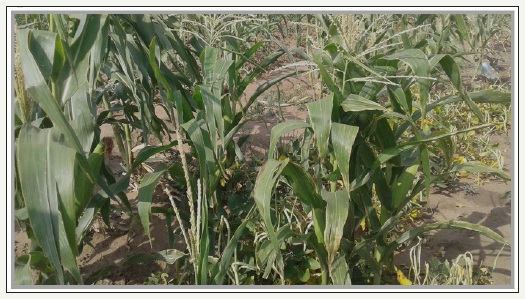
Figure 2:Effect of maize varieties on grain yield under different methods of stem borer management.
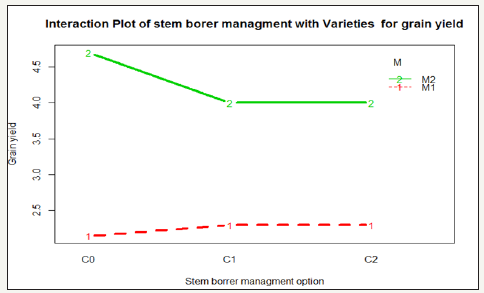
Figure 2 indicated that the effect of maize varieties on grain yield under different Control mechanisms of stem borer. Improved Maize Variety (MH-130) mono-cropping produced significantly higher grain yield as compared to other treatment combination. Grain yields were affected by Maize varieties x Control mechanisms of stem borer interaction. Generally grain yield mostly increased under the interaction of improved maize variety under different Control mechanisms of stem borer as compared to local variety interaction under different Control mechanisms of stem borer.
Figure 3:Effect of maize varieties on biomass yield under different methods of stem borer management.
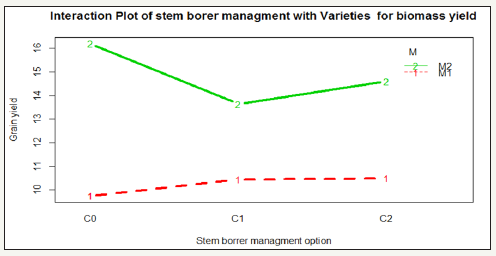
Similar result also designated in Figure 3 that the effects of maize varieties on biomass yield under different Control mechanisms of stem borer. Likewise Improved Maize Variety (MH- 130) mono-cropping produced significantly higher biomass yield as compared to other treatment combination followed by Improved Maize Variety (MH-130) inter-cropping with Cowpea and Sudan Grass and Improved Maize Variety (MH-130) inter-cropping with Cowpea respectively. Generally biomass yield habitually increased under the interaction of improved variety under different Control mechanisms of stem borer as compared to local variety interaction under different Control mechanisms of stem borer.
Table 4:Mean comparison of days to maturity and some agronomic characteristics of maize varieties. M1= Local Maize variety Mono-cropping, M2= Improved Maize variety (MH-130) mono-cropping.

Days to maturity are also the other important yield parameter of maize crop. It directly affects grain yield of maize. The data regarding Days to maturity are given in Table 4. The data showed that Maize variety had significant effect on Days to maturity. While, Control mechanisms of stem borer and the interaction effect have non-significant (P≤0.05) effect on Days to maturity. In case of Maize varieties, maximum mean value of Days to maturity (87.3) was observed in Improved Maize variety (MH-130) mono-cropping which is significantly different from Local Maize variety Monocropping. Plant height, Ear length and Harvest Index are likewise the additional important yield parameter of maize crop. It directly upsets grain yield of maize. The data regarding Plant height, Ear length and Harvest Index are given in Table 4. The data showed that Maize variety had significant effect on Plant height. While, Control mechanisms of stem borer and the interaction effect have nonsignificant (P≤0.05) effect on Plant height, Ear length and Harvest Index respectively. In case of Maize varieties, maximum mean value of Plant height (137.9), Ear length (40.57) and Harvest Index (28.78) was observed in Improved Maize variety (MH-130) monocropping which is significantly different from Local Maize variety Mono-cropping similarly (Figure 4).
Figure 4:Grain yield of improved seed (MH-130) from one plot of the experimental site.
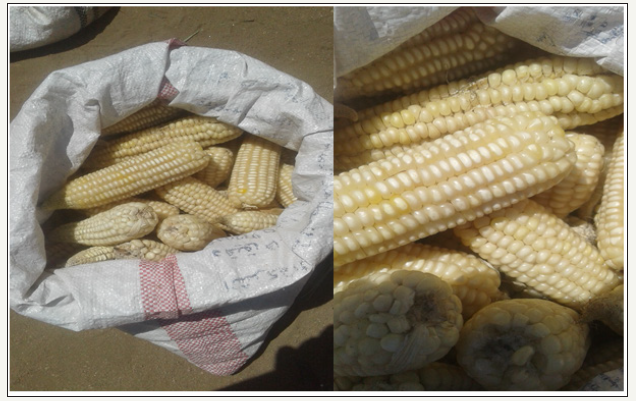
Correlation
Table 5:Correlation among the agronomic traits of maize inter-cropping.

Correlation analysis among yield parameters of maize was done and this revealed highly significant positive associations among some of the growth and yield parameters studied (Table 5). The positive association of traits ensures that selection on the simple traits is conceivable to advance grain yield. Accordingly, plant height was highly significantly and positively correlated (R=0.66) with grain yield. This means when plant height of the maize plant was increasing, its grain yield was also increasing according to this study. Likewise Ear length was significantly and positively correlated (R=0.58) with grain yield. The positive association between Ear length and grain yield designates that when Ear length increase the grain yield of the maize also increase.
In similar manner, the biomass yield was highly significantly and positively correlated (R=0.76) with grain yield and this indicated that when the biomass yield of maize is increasing, its grain yield was also increasing. Grain yield was significantly and positively correlated (R=0.74) with harvest index of maize and according to the current result the treatment that increased the grain yield could result in increased harvest index. Thus the result of the current correlation analysis of Maize varieties and Control mechanisms of stem borer interaction with higher biomass yield and harvest index could result in higher grain yield of maize. Similarly biomass yield rate (R=0.73) and grain yield per day (R=0.96) was also positively correlated with grain yield.
Farmers evaluation
The farmers who participated and evaluated the trial were representative to the area and having long experience in farming. Before beginning of the selection process, selected farmers from the kebelle were asked to set their priority selection criteria. Accordingly, Maturity, Ear length, Plant Height, Resistant to stem borer and Stress tolerance were identified as the most important farmers’ selection criteria. Ranking of varieties were done on a scale of 1-6, 1 being very good and 6 being very poor.
Figure 5 showed the farmers evaluation of the treatment combination based on the criteria they set. Based on the assessment of the farmers that shown in figure 5, Treatment 4(M2*C0) Improved Maize Variety (MH-130) mono-cropping was ranked the first (1.1), followed by Treatment 5(M2*C1) Improved Maize Variety (MH-130) inter-cropping with Cowpea (2.3), Treatment 6(M2*C2) Improved Maize Variety (MH-130) inter-cropping with Cowpea and Sudan Grass (2.8), Treatment 1 (M1*C0) Local Maize variety Mono-cropping (4.3), Treatment 2 (M1*C1) Local Maize variety inter-cropping with cowpea (4.5), and Treatment 3 (M1*C2) local Maize varieties inter-cropping with Cowpea and Sudan Grass (6.0) respectively.
Understanding farmers’ perception and priorities is crucial to facilitating adoption of any technology (Chambers & Ghildyal and Sperling et al.). Although Ear length is usually considered a priority trait to maximizing yield, it ranked a distant fourth when compared with Stress tolerance, Maturity and Resistant to stem borer traits that were ranked first, second and third respectively by the farmers (Figure 5).
Figure 5:Preference rank of Treatments.
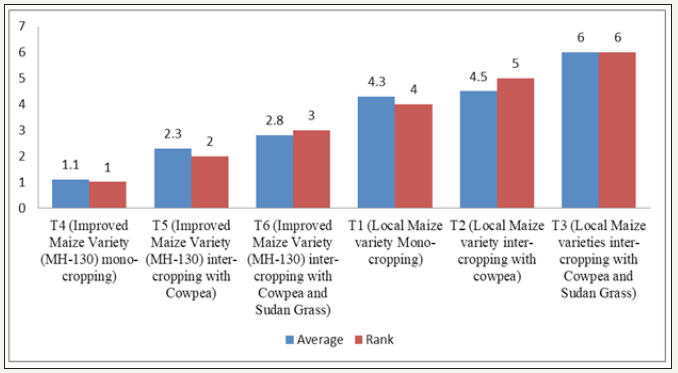
As noted by Snapp and Slim, 2000, while researchers may monitor returns by measuring crop yields per land area, farmers assess a range of other traits which often make their perceptions of returns quite different from those of researchers. Thus, involving farmers early in the process of variety selection, as was demonstrated in this study, will enhance early adoption of desirable technologies.
Acknowledgement
We are indebted to individuals and institutions whose valuable contributions have enabled the completion of this research. We would like to express our first and foremost gratitude to Pastoral Community Development Program (PCDP) for its financial support. Special gratitude goes to the interviews and focus groups for generosity in providing crucial information. Our gratitude goes to Jigjiga University for providing necessary facilities and support during this report preparation and the whole research time.
References
- Khan ZR, Hassanali A, Pickett JA, Wadhams LJ, Muyekho F (2003) Strategies for control of cereal stem borers and striga weed in maize-based farming systems in eastern Africa involving ‘push-pull’ and allelopathic tactics, respectively. African Crop Science Conference Proceedings 6: 602-608.
- El-Wakeil NE (1998) Relationship between egg -cluster size of corn borers Ostrinia nubilalis (Hb.) and Chilo Agamemnon (Bles) and the rate of Parasitism of Tricho gramma evanesces. Egyptian J Appl Sci 13: 611- 619.
- Kfir R ( 1997) Competitive displacement of Busseola fusca (Lepidoptera: Noctuidae) by Chilo partellus (Lepidoptera: Pyralidae). Annals of the Entomological Society of America 90(5): 619-624.
- Degri MM, Mailafiya DM, Mshelia JS (2014) Effect of intercropping pattern on stem borer infestation in pearl millet (Pennisetum glaucum L) Grown in the Nigerian Sudan Savannah. Advances in Entomology 2(2): 81-86.
- Harris C, W Nwanze, KE (1992) Busseola fusca (Fuller), the African maize stalk borer: A handbook of information. In Information Bulletin, ICRISAT, CAB International, Oxon, UK, p. 85.
- Van den Berg J, van Rensburg JBJ, Pringle KL (1991) Comparative injuriousness of Busseola fusca (Lepidoptera: Noctuidae) and Chilo partellus (Lepidoptera: Pyralidae) on grain sorghum. Bulletin of Entomological Research 81(2): 137-142.
- Khan ZR, Pickett JA (2004) The ‘push-pull’ strategy for stem borer management: A case study in exploiting biodiversity and chemical ecology. In: Gurr G, Waratten SD, Altieri MA (Eds.), Ecological engineering for pest management: Advances in habitat manipulations for arthropods. CSIRO and CABI Publishing, Australia, pp. 155-164.
- Cook SM, Khan ZR, Pickett JA (2007) The use of ‘push-pull’ strategies in integrated pest management. Annu Rev Entomol 52: 375-400.
- Khan ZR, Muyekho FN, Njuguna E, Pickett JA, Wadhams LJ, et al. (2007) A primer on planting and managing ‘Push-Pull’ fields for stem borer and striga weed control in maize (2nd edn), ICIPE Science Press, Kenya, pp. 1-60.
© 2018 Fano Dargo. This is an open access article distributed under the terms of the Creative Commons Attribution License , which permits unrestricted use, distribution, and build upon your work non-commercially.
 a Creative Commons Attribution 4.0 International License. Based on a work at www.crimsonpublishers.com.
Best viewed in
a Creative Commons Attribution 4.0 International License. Based on a work at www.crimsonpublishers.com.
Best viewed in 







.jpg)






























 Editorial Board Registrations
Editorial Board Registrations Submit your Article
Submit your Article Refer a Friend
Refer a Friend Advertise With Us
Advertise With Us
.jpg)






.jpg)














.bmp)
.jpg)
.png)
.jpg)










.jpg)






.png)

.png)



.png)






